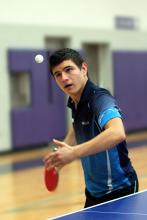Written By Professional Coach Richard McAfee
I often see players spending large amounts of practice time working on a single stroke that they wish to improve. Most often this involves hours of executing the stroke over and over and in conjunction with simple footwork drills. After all this work, the athlete is often disappointed to find that during competition that the same well-practiced stroke breaks down. Why does this happen, because the practice they have been doing does little to link the stroke to the rest of the player’s game.
The answer is not more practice but more effective practice methods. First when learning a new technique or trying to modify an existing stroke, some simple repetition is necessary. However as soon as the basic skill is under control, your drills should switch to linking the new skill with the rest of your game. Most table tennis points are won by the time the ball has been struck five times so let’s take a look at each of these first 5 possible strokes:
1st ball – Serve
2nd Ball – Serve return
3rd Ball – First attack (Initiate) or Counter-Initiate
4th Ball – First Defense or Counter-Initiate
5th Ball – Second attack or Counter-Initiate
When practicing a particular stroke, it is important to practice it in each of the above five positions that it could be used. The idea is to “link” your new or improved stroke with the strokes that will both come before or after it so you’re whole “stroke sequence” is strong.
For example, let’s say you want to improve your backhand topspin. A drill session built around the first 5 balls of a point would include:
· 2nd Ball- Serve Return Drill – Your partner would serve mixed short and long serves to your backhand and you would return using your backhand flip or topspin and then play out the rest of the point.
· 3rd Ball – First Attack Drill – You would serve short serves to partner who returns with a drop or long push to your backhand side, you then make an attach with your backhand topspin (or flip) and play out the point.
· 3rd Ball – Counter-Initiate Drill – You serve mixed short or long serves to your partner’s backhand. Your partner attacks with topspin to your backhand and you counter-attack using your backhand topspin and play out the point.
· 4th Ball – Counter-Initiate Drill – Your partner serves short and you push anywhere. Your partner then makes a topspin attack directed to your backhand and you counter-attack using your backhand topspin and play out the point.
· 5th Ball – Second Attack Drill – You serve mixed short and long serves to your opponent’s backhand, your partner returns the serve to your backhand, you make a first backhand topspin anywhere, and your opponent returns with a counter-topspin to your backhand and you try to finish the point with a strong backhand topspin then play out the point.
As you can see from the above example, you will have practiced your backhand stroke with these drills but also “linked” the stroke to the rest of your game. This form of practice will not only help you develop your strokes but make them much more effective in a match situation. You can use this concept to work on almost any stroke in your game. Remember the answer to improving your game is to improve the effectiveness of your practice drills.
Effective Stroke Practice

Learn what you should be practicing!
Category:



